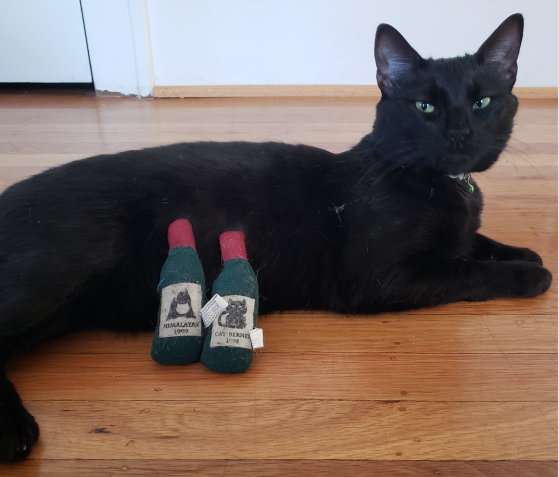“In the end, I had antibodies and a dog named Fauci.”
That’s how Los Angeles attorney Kari Milone says she chose to look back on the eight months she spent trying to adopt a rescue dog in 2020 — a period of time during which she didn’t not only did she lose her second dog in less than a year, but she also survived COVID-19.
Named after Dr. Anthony Fauci because “he has a white coat and was abandoned during COVID,” the Fauci dog is one of about. 3.2 million animal shelter that the American Society for the Prevention of Cruelty to Animals (ASPCA) estimate is adopted every year. This year, the demand for animal adoption is on the rise: as stay-at-home orders were issued in the United States in March in response to the coronavirus pandemic, the ASPCA shared that according to industry data PetPointanimal welfare organizations across the country saw a spike in adoptions during the second half of March, with an estimated national adoption rate of 58% at the start of the month, jumping to 85% at the end of the month.
“We have seen an incredibly compassionate response from people willing to open their homes to foster and adopt vulnerable shelter animals during this period of uncertainty and applaud you for doing so heroically for animals in need,” says the president and CEO of ASPCA Matt Bershadker. “This unprecedented compassionate response from communities across the country to support their local shelters reflects the widespread appreciation of the invaluable role pets play in our lives.”
Despite fears that the stay-at-home order would result in shelters being flooded with animals due to an increase in abandoned animals, officials from rescue organizations such as Chicago Animal Care and Control (CACC) and the Los Angeles Society for the Prevention of Cruelty to Animals (spcaLA) say the opposite has been true.
“When the stay-at-home orders were put into motion, we were anxious about the possibility of seeing an increase in admission requests and a decrease in transfers and adoptions,” says CACC Public Information Officer Jennifer Schlueter. “We are so pleased to experience the exact opposite of what we were previously afraid of… The demand for adoptable and adoptable animals coupled with a decrease in intake has led us to be around 30 animals for a while at the late spring and early summer.
In Los Angeles, the president of spcaLA, Madeline Bernstein, says that the shelter adopts animals as they come in. “This is true across the country,” he says. “Animal shelters have been emptied of adoptable animals through adoptions or fostering, because of what is a good time, when families are at home together during the lockdown, to work with a new pet. And it’s also a cover against loneliness.”
It’s a trend that doesn’t surprise longtime pet owners like Caitlin McCarthy, who understands firsthand how comforting pets can be, especially in times of stress or isolation. After her dog, a Westie named Oscar, died in September, McCarthy, a teacher at Worcester Public Schools in Massachusetts, says she wasn’t able to last long without a fur baby.
“This pandemic has been a very isolating situation,” he says. “I was grateful to have time with Oscar because his health had started to fail when the schools closed, so I was able to be with him. But after he died, I really noticed not having him at home because he was a family member. I didn’t go out. I really missed having a dog.”
So when she saw this Northern New England Westie Rescue Inc. had shared some photos on Facebook of a few dogs that were up for adoption, he jumped at the chance. “I immediately sent him a message,” she says. “It wasn’t even something I thought about. I just did it. Because I knew. I saw the little faces and I knew one of them had to be mine.
About a week later, McCarthy met a volunteer driver in the parking lot of an Olive Garden to pick up Finbarr, a 10-year-old Westie who had been rescued from a Kansas “puppy mill.” As soon as she held him, she says she knew they had a connection.
“I gravitated towards the photo of him that (the rescuer) had posted on Facebook. There was just something very animated in his eyes. So I told him that I would be happy with any dog, but if I could meet him, I think it’s the dog for me,” he says. “I went to get him and they opened the back of the car and there he was. I was so excited and he was shy, as you can imagine. But as soon as I picked him up, he licked me right on the cheek. It’s like” and he knew, as he said, “You’ll be my girl, won’t you?” And the answer was yes.

Since arriving at her new home on October 26, Finbarr (a name McCarthy says she chose because her late mother loved him) has blossomed before McCarthy’s eyes. “He was used as a puppy raiser for 10 years. His whole life he was in a cage. He didn’t know what a toy was. He never had a name. He had never been outside to play. So he I teach all these things,” he says. “And it’s very healing for me too. It’s like a furry test of hope in a very worrying time. When you see a dog that has survived the most terrible circumstances and that it continues to get better and better every day, how can you not feel hope in life in the future?
The emotional support that pets can offer their owners is more crucial than ever at this time, says Rachael Silverman, a psychologist specializing in couple and family psychology who often prescribes emotional support animals for patients. “With so much uncertainty and instability, animals provide people, especially children, with unconditional love, support and comfort, and serve as a distraction,” he says. “I had an 8-year-old patient who told me how she shared her adopted cat with her grandmother so that her grandmother had a piece of her with her and she didn’t feel alone because she couldn’t visit.”
Staying at home in the middle of the pandemic has also encouraged many pet owners for the first time to take a step of safety, and in doing so, discover how emotionally charged animals can be. Since adopting his dog Nana, a 6-year-old boxer mix, from Badass Brooklyn Animal Rescue in April, Crystal Kayiza and Peter Quandt came to learn that he has a strange talent to lift the spirit.
“She’s such a joy to have and she’s really in tune with what people are feeling. I think everyone says that about their dog, but she’s definitely aware of when someone is having a bad day,” says Kayiza. “He has really little energy and just wants to hug people and lie down. I think what has been needed a lot in this time is to be able to take a break from watching screens and just sit on the floor with my dog for a while.”

Of course, it’s not just dogs that provide these much-needed moments of levity. When Elise Healy and her partner realized they couldn’t make a trip to France they had planned for March to celebrate the end of grad school, they decided to adopt a new cat instead. They ended up rescuing Poe, a short-haired black domestic Seattle Area Feline Rescuewho, along with his other cat Keaton, helped him deal with spending the year at home.
“(Poe) is crazy. He likes to be chased around the house and play and will randomly jump into our laps and hang out with us. He falls off his cat tower, often. I don’t think I can adequately explain how much wild and fun,” says Healy. “It breaks the day to be sitting at your desk working and bored and then, you know, suddenly you have a box moving around the house because it got into it and can’t get out.”

2021 also looks to be a big year for shelter animals: In January, a shelter dog took up residence in the White House for the first time when President-elect Joe Biden moved in with his dog Major, a German shepherd who the Bidens adopted in 2018 by the Delaware Humane Association (DHA). It will be a landmark day for supporters of “adopt, don’t buy,” a growing movement that encourages people to adopt pets from shelters and rescue groups instead of buying from commercial breeders.
“Our staff and our volunteers are super excited about Major going to the White House mainly because it highlights the important work we do to find great homes for dogs and cats. It’s like, if one of our adoptees DHA is good enough for the White House, it’s good enough for your house, right?” says DHA Executive Director Patrick Carroll. “And it’s not just DHA. It highlights adoption for all shelters in Delaware and across the country. I think having a shelter dog go to the White House is really going to help with that awareness.”
That Major and Biden’s other dog, Champ, are headed to the White House will also mark the return of the ancient tradition of presidential pets. “Americans are the most pet owners,” says Andrew Hager, historian-in-residence at the U Presidential Animal Museum. “We expect that from our presidents and we’ve gotten it for the most part because presidents come from the American people and that’s part of our culture.”
The Bidens are reported I plan to bring a cat too. Perhaps, like many other Americans, they have been bitten by the pet adoption bug. Milone, for one, says that, although it has only been a few weeks since Fauci came home, his presence has already made one thing clear to her: despite the challenges she faced the first time, she wants to save another dog, and soon. . “The only thing I have become absolutely sure of is that I will get another rescue,” he says. “I need a month to be good with (Fauci), because he and I know each other really well. So I will take a second.”



